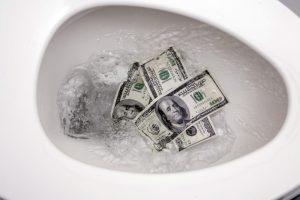Are You Flushing Money Down the Drain?
May 3, 2016
Drip…Drip…Drip
Doesn’t it drive you crazy?
Wush…Wush…Wush
Running all hours of the day or night, don’t you hate the sound of money flowing down the drain?

If you hear that sound, you’re wasting money — a lot more than you think.
How much money could you possibly be wasting? You can easily lose $2000 in one year from a leaking toilet. That’s like flushing a 4k TV or a late 90’s BMW down the drain.
A leaking faucet and a running toilet are the most common ways in which inefficient plumbing wastes your money — as well as clean water, the most important resource on Earth.
The Danger in a Little Leak?
True, the individual droplets of water are small, almost unnoticeable. It’s easy to assume you can ignore them. But they drip constantly. Over time, those little droplets add up to whole swimming pools worth of wasted water.
- A leaking faucet can waste approximately 10 gallons per day
- A running or leaking toilet can waste several hundred gallons per day, adding up to $200 to your monthly water bill.
Leaky Faucet
Leaking faucets are the most common plumbing problem for homeowners.
Used continuously, everyday, your faucets experience significant wear and tear. Not surprisingly, those faucets are one of the most common places that leakage occurs. Think about how many times per day you and your family washes their hands at just one individual sink.
Reasons why your faucet might leak:
- Corrosion
- Sediment buildup
- Worn-out washer
- Loose parts
- A bigger plumbing issue, like a broken pipe
Calculate Your Waste
See how quickly a small drip adds up. You can calculate your daily and yearly leakage totals using the United States Geological Survey’s drip calculator.
Troublesome Toilets
A faulty toilet wastes 200X the amount of water as a leaky faucet. That deserves your attention.
A running or leaking toilet creates no mess, because all of the leaking water drains directly into the sewer. While that may sound convenient, the lack of symptoms makes it a difficult issue to diagnose.
In fact, the massive spike in your water bill spike often stands out as the first clue.
Wush…Wush…Wush… that painfully monotonous sound looms large as your second clue.
The average yearly cost of a leaking toilet is $2,000 — way more than you’ll pay to repair it.
One individual’s toilet wasted 73,000 gallons of clean water in one year. Wasting that quantity of clean water equates to filling and draining a luxurious in-ground pool four or five times times over.
Food Dye Test
Steps:
- Known as the food dye test, a safe and simple DIY method exists to detect a running toilet.
- Remove the lid on your toilet tank
- Add colored food dye to the water
- Wait fifteen minutes
- If the toilet bowl water starts to change color, a leak is guaranteed.
Methods of home testing are cheap but unreliable. Even if the food dye test is negative, a leak can still be occurring. Especially if your water bill reflects a spike.
Leaks in Conclusion
Fixing your plumbing is equally an environmental and financial issue.
Water is too precious of a resource to waste. Both faucets and toilets draining water can hurt you like a financial punch to the gut.
Also, if for some reason, you’ve become fond of the sound of dripping water and find it relaxing, please fix it anyway.
Now is the time to look for and fix leaking faucets and toilets.
Contact Us to find and fix wasteful plumbing.